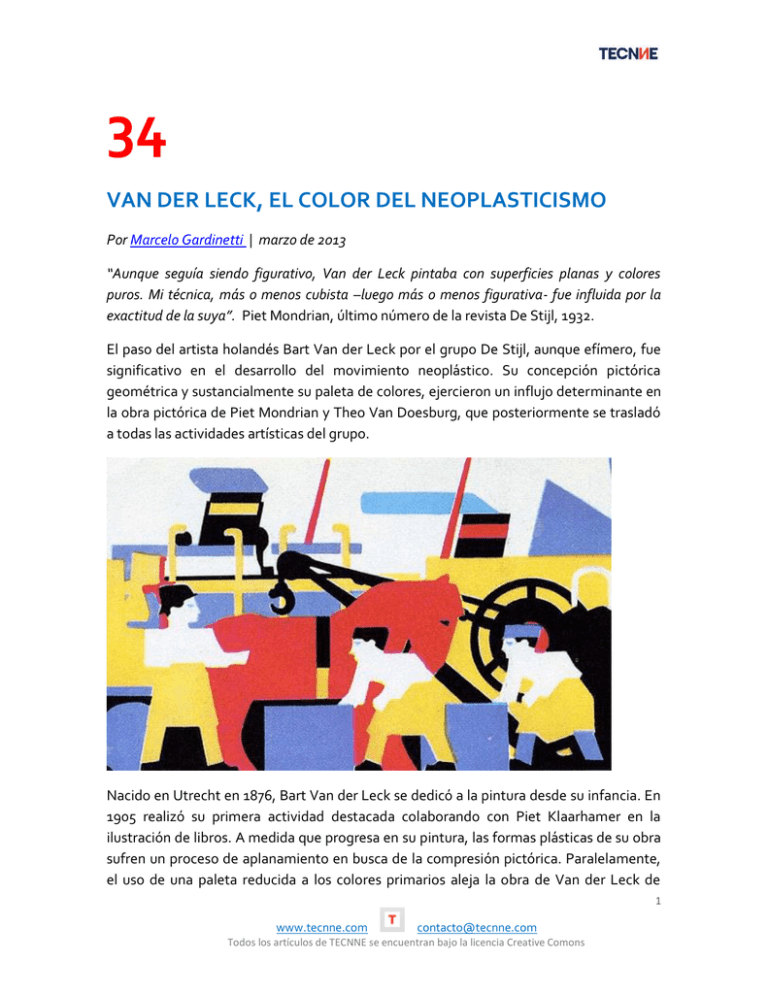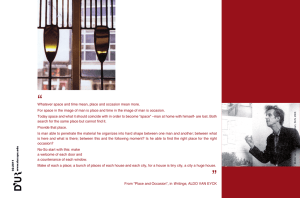van der leck, el color del neoplasticismo
Anuncio

34 VAN DER LECK, EL COLOR DEL NEOPLASTICISMO Por Marcelo Gardinetti | marzo de 2013 “Aunque seguía siendo figurativo, Van der Leck pintaba con superficies planas y colores puros. Mi técnica, más o menos cubista –luego más o menos figurativa- fue influida por la exactitud de la suya”. Piet Mondrian, último número de la revista De Stijl, 1932. El paso del artista holandés Bart Van der Leck por el grupo De Stijl, aunque efímero, fue significativo en el desarrollo del movimiento neoplástico. Su concepción pictórica geométrica y sustancialmente su paleta de colores, ejercieron un influjo determinante en la obra pictórica de Piet Mondrian y Theo Van Doesburg, que posteriormente se trasladó a todas las actividades artísticas del grupo. Nacido en Utrecht en 1876, Bart Van der Leck se dedicó a la pintura desde su infancia. En 1905 realizó su primera actividad destacada colaborando con Piet Klaarhamer en la ilustración de libros. A medida que progresa en su pintura, las formas plásticas de su obra sufren un proceso de aplanamiento en busca de la compresión pictórica. Paralelamente, el uso de una paleta reducida a los colores primarios aleja la obra de Van der Leck de 1 www.tecnne.com [email protected] Todos los artículos de TECNNE se encuentran bajo la licencia Creative Comons cualquier referencia conocida, dando vida a un estilo propio que transita lentamente desde lo figurativo hacia la abstracción. En 1916 se traslada a Laren, donde expone en el museo privado de la Sra. Kröller – Muller sus obras “Trabajo en muelles” y “La tormenta”. Van der Leck era diseñador gráfico, un hecho que trascendió en su pintura plasmada en colores planos contenidos entre franjas negras que organizaban el espacio. Ese mismo año conoce a Piet Mondrian, con quien traba una sólida amistad. En esos años Mondrian había limitado su paleta de colores a los rosas, ocres y azules, pero a partir de su contacto con Van der Leck decide utilizar una paleta restringida únicamente a los colores primarios, complementados con negro, gris y blanco. Por iniciativa de Mondrian, Van Doesburg toma contacto epistolar con Van der Leck y le solicita fotografías de sus obras para darlas a conocer en una publicación. Sin embargo Van der Leck prefiere que tenga contacto directo con sus pinturas y lo invita a recorrer la exposición que realiza en la galería Kröller- Muller. Van Doesburg queda gratamente sorprendido al ver su obra, que define como una “aplicación pura y madura de los principios del arte plástico”. A partir de esta visita su trabajo también adopta colores primarios y formas regulares. Cuando en 1917 Van Doesburg decide editar la revista De Stijl, concluye que la obra más clara a los fines neoplásticos es la pintura de Van der Leck. Invitado a participar, Van der Leck escribe un artículo para el primer número de la revista. Sus ideas referidas la relación entre la arquitectura y la pintura diferían considerablemente con las de Van Doesburg. Tampoco adhería a la pintura no figurativa ni a la rígida geometría. Las teorías elaboradas por Van Doesburg y Mondrian para De Stijl no estaban dentro de su concepción pictórica. 2 www.tecnne.com [email protected] Todos los artículos de TECNNE se encuentran bajo la licencia Creative Comons La negativa de Van der Leck a firmar el primer manifiesto fué considerada por el resto del grupo como una separación prematura. Para disipar estas sospechas, escribe a Van Doesburg: “En lo que a mi refiere, no hay nada de alejamiento de De Stijl, y le ruego que considere mi negativa a firmar como un hecho aislado.” No obstante, su alejamiento del grupo fue consumado a partir de ese momento. Volvió al realismo, imprimiendo un estilo que inicio en 1918 con “el Jinete” y lo acompañara hasta su muerte acontecida en 1958. A pesar del escaso tiempo en que participo del grupo, Van der Leck trazó una huella indeleble en el desarrollo de De Stijl. La paleta de colores primarios, el carácter geométrico y la planitud espacial, son resultado directo de su influjo sobre el resto de los artistas del grupo De Stijl. La serie cromática se revalida en la pintura de Mondrian, Van Doesburg y Vilmos Huzar. En la arquitectura de Oud, Rietveld y Van Eesteren. En la obra plástica de Vantongerloo y Domela. En el mobiliario de Rietveld. Bart Van Der Leck, el artista de paso fugaz por el movimiento neoplástico, dejo su marca en una paleta de colores que se transformó en el sello distintivo del grupo De Stijl. English version VAN DER LECK, THE COLOR OF THE NEOPLASTICISM By Marcelo Gardinetti | March 2013 “Although still figurative painting Van der Leck with flat surfaces and pure colors. My technique, more or less Cubist, then more or less figurative, was influenced by the accuracy of his.” Piet Mondrian, latest issue of the magazine De Stijl, 1932. The move by the Dutch artist Bart Van der Leck by the group De Stijl, although ephemeral, was significant in the development of neoplastic movement. His pictorial conception 3 www.tecnne.com [email protected] Todos los artículos de TECNNE se encuentran bajo la licencia Creative Comons geometric and substantially your color palette, exercised decisive influence on the paintings of Piet Mondrian and Theo Van Doesburg, who later moved to all artistic activities of the group. Born in Utrecht in 1876, Bart Van der Leck was devoted to painting since childhood. In 1905 he made his first major activity in collaboration with Piet Klaarhamer book illustration. As you progress through your paint, plastic forms of his work undergo a process of flattening in search pictorial compression. In parallel, using a reduced palette to primary colors away the work of Van der Leck any known reference, giving life to a style that moves slowly from figurative to abstraction. In 1916 he moved to Laren, where he exhibited in the private museum of Mrs Kröller – Müller his works “Work springs” and “Storm”. Van der Leck was a graphic designer, a fact that was learned in his painting, embodied in spot colors content between black stripes organized space. That same year he met Piet Mondrian, with whom he formed a strong friendship. In those years Mondrian had limited his palette to pinks, browns and blues, but from contact with Van der Leck decide to use only a palette restricted to primary colors, complemented with black, gray and white. On the initiative of Mondrian, Van Doesburg making epistolary with Van der Leck and requested photographs of his works to make them known in a publication. However Van der Leck preferred to have direct contact with their paintings and invites you to visit the exhibition in the gallery performing Kröller-Muller. Van Doesburg is pleasantly surprised to see his work, which it defines as “pure and mature application of the principles of visual art.” From this visit his work also takes regular shapes and primary colors. When in 1917 Van Doesburg decide to edit the magazine De Stijl, concludes that the work for the purpose clearer neoplastic this is paint of Van der Leck. Invited to participate, Van der Leck writes an article for the first issue of the magazine. Your Thoughts regarding the relationship between architecture and painting differed considerably with Van Doesburg. Nor adhered to non-figurative painting or the rigid geometry. The theories developed by Van Doesburg and Mondrian for De Stijl was not within his pictorial conception. The negative of Van der Leck to sign the first manifesto was considered by the rest of the group as a premature separation. To allay these suspicions, writes to Van Doesburg: “As far as I’m concerned, there is no departure from De Stijl, and I beg you to consider my refusal to sign as an isolated event.” 4 www.tecnne.com [email protected] Todos los artículos de TECNNE se encuentran bajo la licencia Creative Comons However, his departure from the group was accomplished since that time. He returned to realism, printing a style that began in 1918 with “Rider” and accompany him to his death occurred in 1958. Despite the short time I participate in the group, Van der Leck drew an indelible mark on the development of De Stijl. The palette of primary colors, geometric character and spatial flatness, are a direct result of its influence on the rest of the group De Stijl artists. The chromatic number is revalidated in painting Mondrian, Van Doesburg and Vilmos Huzar. In the architecture of Oud, Rietveld and Van Eesteren. In the plastic work Vantongerloo and Domela. In the Rietveld furniture. Bart van der Leck, artist fleeting passing neoplastic movement, left his mark on a palette of colors that became the hallmark of the group De Stijl. Imagen de portada: ©Wim van der Groef-flickr . Publicado en TECNNE ©Marcelo Gardinetti Portal de Arquitectura, Urbanismo, Arte y Diseño Cite: “Marcelo Gardinetti, Van Der Leck, El Color del Neoplasticismo; Tecnne” Enlace Corto: http://tecnne.com/?p=8273 5 www.tecnne.com [email protected] Todos los artículos de TECNNE se encuentran bajo la licencia Creative Comons

